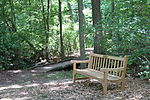Seaview Hospital

Seaview Hospital is a historic hospital complex in Willowbrook on Staten Island, New York. The original complex was planned and built between 1905 and 1938 and was the largest and most costly municipal facility for the treatment of tuberculosis of its date in the United States. After being shuttered, the complex was listed as a national historic district. After many years of sitting empty, portions of the complex have reopened as the Sea View Hospital Rehabilitation Center & Home, which operates as a long-term care and rehabilitation facility in the New York City Health and Hospitals Corporation network. The facility houses a nursing home, independent living facility, and the first long-term care brain injury rehabilitation center in downstate New York.
Excerpt from the Wikipedia article Seaview Hospital (License: CC BY-SA 3.0, Authors, Images).Seaview Hospital
Brielle Avenue, New York Staten Island
Geographical coordinates (GPS) Address Phone number Website Nearby Places Show on map
Geographical coordinates (GPS)
| Latitude | Longitude |
|---|---|
| N 40.591666666667 ° | E -74.132777777778 ° |
Address
Sea View
Brielle Avenue 460
10309 New York, Staten Island
New York, United States
Open on Google Maps






